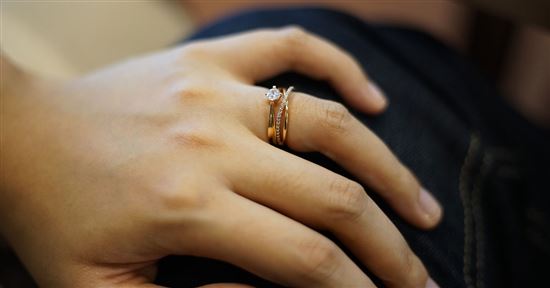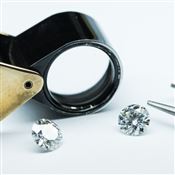10k vs 14k vs 18k Gold Comparison
10k, 14k, and 18k gold - what's best for your engagement ring? Learn the pros and cons of each to find the best that fits with your lifestyle.
 |
Gold (white or yellow) is the most popular metal choice for an engagement ring. If you're looking at a gold setting, you'll have to decide between 10k, 14k, or 18k gold.
Is the higher the better? Is 10k too "cheap" for engagement rings?
The answer depends on what you're looking for. And even personal preference. Read on for everything you need to know about selecting gold for your jewelry.
What is Karat?
Karat (not to be confused with carat) is a measurement of how pure the gold is. The higher the karat, the larger percentage of gold. 24k gold means that all 24 parts of the metal is gold - in other words, pure gold.
Pure 24k gold is not made into jewelry in the U.S. There's no market or demand for it.
There are a few reasons why pure gold is not ideal for rings:
- Pure gold is very soft. It's very easily scratched, dinged, and bent out of shape.
- Pure gold is very pricey. Most people will not pay this premium.
- The color of pure gold is a very rich yellow, to the point of being almost orange. Most people find this too gold and prefer the paler yellow of lesser karat gold.
Because of how soft pure gold is, gold jewelry is made with other alloys mixed into it. This makes the gold strong enough to hold diamonds and gemstones and is more durable for wear.
White Gold or Yellow Gold?
Let's go over this quickly.
When we say "gold" in this article, we're referring to either white gold or yellow gold jewelry. What you get is totally based on personal preference. Here are a couple of things to know:
- Yellow gold is mixed with copper, silver, zinc, nickel, and/or palladium. Of the alloys, the copper content is the highest in order to maintain the gold color.
- White gold is mixed with more silver-colored alloys, like palladium and nickel, to give it a paler color. Then it's plated with rhodium to give it the white gold or platinum look.
- White gold is stronger than yellow gold because of the alloys used in it. Thus, prongs are almost always made with white gold.
Now let's go over the different gold content and pros and cons of each.
10k Gold
- Pros: Great value, most durable
- Cons: Sensitive wearers may have a reaction to the high amount of alloys
- Best for: Very active wearers and those on a budget
10k gold means that the metal is 10 parts gold and 14 parts alloy (or 41.7% gold). This is the lowest gold content you can have for the metal to be considered "gold" in the U.S.
Because of the high percentage of alloys, 10k gold is very durable, which makes it a great choice for very active wearers. It's also the cheapest because there's actually more alloy than gold. This makes it a great value buy if you're on a limited budget.
The color is a paler yellow, which I personally prefer. But if you're concerned about whether people will think you got a "cheap" piece of gold jewelry, don't be. Most people can't tell the difference between 10k and 14k gold.
Unfortunately, if you're looking for a 10k gold engagement ring, most high-quality jewelers don't carry it. Check with your local jeweler if they have 10k ring settings. It is possible to buy your own setting and get a diamond from somewhere else mounted on it.
14k Gold
- Pros: Great balance of price and quality, still very durable
- Cons: No major downsides
- Best for: Active wearers, everyone
14k gold means that the metal is 14 parts gold and 10 parts alloy (or 58.3% gold). This is the most popular choice in the U.S.
It's still very durable and holds up to active wear and tear. It has a nice rich yellow luster that's not overly yellow. Pricing-wise, it's more expensive than 10k gold, but still affordable. Therefore, 14k gold offers a great balance of price, quality, and appearance.
Usually those with sensitive skin will find that 14k gold is good enough. In rare cases, if you're very sensitive to alloys, you may need 18k gold.
18k Gold
- Pros: Rich gold hue, no skin irritation
- Cons: Scratches more easily, a lot more expensive
- Best for: Those on higher budgets, very sensitive skin
18k gold means that the metal is 18 parts gold and just 6 parts alloy (or 75% gold).
Since 18k gold is mostly real gold, it's more easily scratched than 14k. Generally, it's still strong enough for daily wear. But active girls should choose something more durable.
Because of the high gold content, 18k gold is the most expensive.
So do you really need to spend the extra hundreds on something that has little to no difference? If you love knowing that your ring is more precious, then by all means, go for it! Just as long as you understand 14k does the job just as well and costs a lot less.
Bottom Line
When deciding which gold content to go with, consider your activity level, color preference, skin sensitivity, and of course - budget. All of them make great engagement ring options.
In general, 14k will suit everyone and offers an ideal balance of all factors, while 10k is a great option for those on smaller budgets.
And if you really appreciate the color of gold or like having the finer things in life, 18k gold offers a little luxury.
Write to Anna G at feedback@creditdonkey.com. Follow us on Twitter and Facebook for our latest posts.
|
|
|



